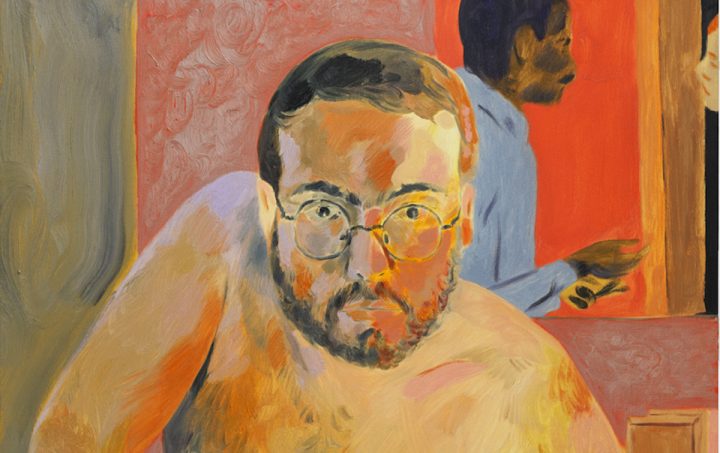
PARIS — In The moon sets a knife, Anthony Cudahy’s latest solo exhibition at Semiose Gallery, characters from art history, queer archives, and personal photographs coalesce. Joyful, somber, and often quotidian unions fill compositions on canvas and paper. The artworks on display suggest that the Brooklyn-based painter’s approach to mimesis is as closely attuned to the ageless postures and gestures of his subjects as it is to their physiognomies. By demonstrating the extent to which human behaviors are both learned and transient, these fictionalized scenes express an indisputable truth: as discrete individuals, we are merely vessels for the habits and beliefs which we accumulate in our lifetimes.
The moon sets a knife follows a year after Cudahy’s first show in France (also at Semiose), titled Flames; a suite of surreal, primarily duotone acrylic works on paper, painted in an electric neon palette. By comparison, the works in this exhibition hew closer to realism, but Cudahy’s oeuvre is hard to pin down under any single style. This is a credit to his willingness to experiment with different mark-making techniques. He often renders the features of his figures using crisp, striated brushstrokes superimposed on chalky washes of red, pink, or ashy blue. Other elements are painted with bold, Fauvist brushstrokes: just one mark evokes an earlobe, a coiled finger, or the sheen of light thrown back by a figure’s shirt collar. Cudahy received an MFA in Studio Art from Hunter College in December 2020, and it’s refreshing to see an artist in the early stages of their career avoid the pitfall of turning their representational style into an identifiable “brand.”
-

Anthony Cudahy, “Twinned” (2021), oil on canvas, 48 × 36 inches (photo by A. Mole) -

Anthony Cudahy, “Conversation i” (2021), oil on canvas, 48 × 36 inches (photo by A. Mole)
Bathed in unnatural colors, these paintings carry an oneiric atmosphere, and the allusions they make to external sources also follow a kind of dream logic. Unravelling the references in any discrete work is made difficult by Cudahy’ inclination to blend them. Some, such as the citation of a William Blake illustration in the subject matter and title of “Blake Moon” (2021), are canonical and therefore relatively easy to identify. Others — those taken from the artist’s personal life, for example — are practically unknowable.
Cudahy’s works at Semiose could be evenly divided into two groups: depictions of solitary figures and depictions of couples, though even the companionless figures in these paintings do not look like they’re truly alone. The perspective from which they are painted implies that the viewer is no more than an arm’s length away; they could exchange glances or words with us if they wanted to. Cudahy’s twosomes, meanwhile, engaged as they are in verbal and physical exchanges, supply categorical assurance that we will always seek, lose, and waste one another’s comfort in this, and any human city.

Anthony Cudahy, The Moon Sets A Knife continues through July 3 at Semoise (44 Rue Quincampoix, 75004 Paris, France).
0 Commentaires